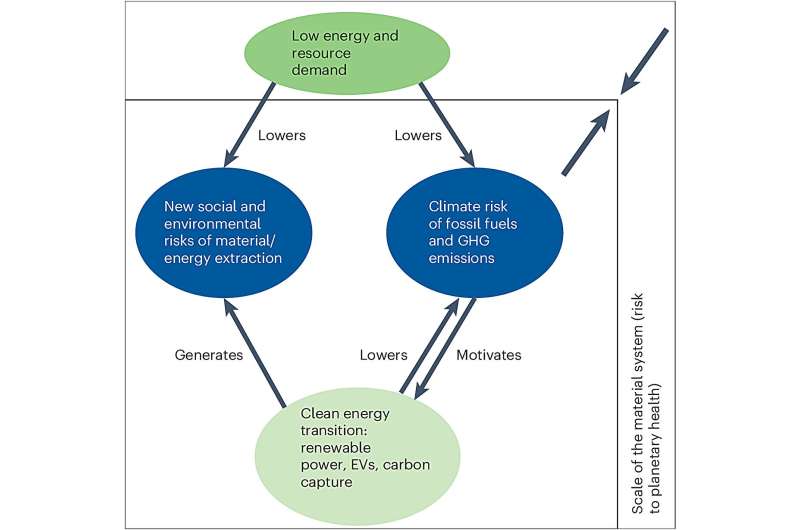This article has been reviewed according to Science X's editorial process and policies. Editors have highlighted the following attributes while ensuring the content's credibility:
fact-checked
peer-reviewed publication
trusted source
proofread
Researchers present innovative demand strategies for clean energy

A perspective piece published in Nature Climate Change describes innovative strategies that significantly reduce both resource consumption and fossil fuel emissions.
The study led by Felix Creutzig from the Mercator Research Institute on Global Commons and Climate Change (MCC) in Berlin, with the collaboration of IIASA researchers Alessio Mastrucci, Charlie Wilson, and Volker Krey, as well as many collaborators from the IIASA-led CircEUlar and EDITS research projects, discusses an optimistic scenario from a climate protection perspective, in which the use of fossil fuels can be rapidly reduced.
New materials, new problems?
By phasing out fossil fuels, the production of raw materials is reduced as the extraction of natural gas, oil, and coal is no longer necessary. This also reduces emissions of greenhouse gases and other pollutants. However, the key question is whether the demand for raw materials and land for renewable energies, electric cars, and sustainable transport infrastructure will lead to additional social and environmental impacts.
"Material extraction and waste streams, the construction of new infrastructure, the associated land use changes and the provision of new types of goods and services related to decarbonization will create social and environmental pressures at local to regional levels," explains Krey, who leads the Integrated Assessment and Climate Change Research Group at IIASA.
"So-called rare earths are, for example, needed for wind turbines and electric cars, lithium and cobalt for batteries, and construction materials for green infrastructure."
"Our study provides an overview of the social, ecological, and geopolitical risks of these materials. These include the displacement of people from residential areas where the raw materials are extracted, health effects due to toxic emissions, injuries, and deaths due to occupational accidents, cartel structures, corruption, and other grievances," adds co-author Helmut Haberl from the University of Natural Resources and Life Sciences (BOKU), Vienna.
To limit these problems, it is necessary to keep energy and resource requirements as low as possible through demand-side measures.
"Our study shows that there is considerable potential to reduce energy and resource consumption without having to impose restrictions," notes Creutzig.
Solutions for both sides
While the need for materials to support a clean energy infrastructure is substantial, it remains significantly lower than the demand generated by the ongoing reliance on fossil fuels. Demand-side strategies, such as improving resource efficiency, replacing individual mobility with shared or public transport, reusing or recycling existing materials, and the thermal refurbishment of buildings play a decisive role here.
The study highlights models that promote shared mobility (including car and ride sharing), which drastically reduces the need for private vehicles. This significantly reduces both material consumption and emissions.
"Our study emphasizes the dual benefits of demand-side solutions in mitigating climate change and reducing material consumption," says Creutzig. "By focusing on efficiency and circular economy principles, we can achieve significant environmental and social benefits."
The research team calls for increased interdisciplinary cooperation and new ideas in policy design to make effective use of these demand-side measures. They underscore the importance of integrating such strategies into global climate protection plans to ensure a holistic approach to sustainable development.
More information: Felix Creutzig et al, Demand-side strategies key for mitigating material impacts of energy transitions, Nature Climate Change (2024). DOI: 10.1038/s41558-024-02016-z


















